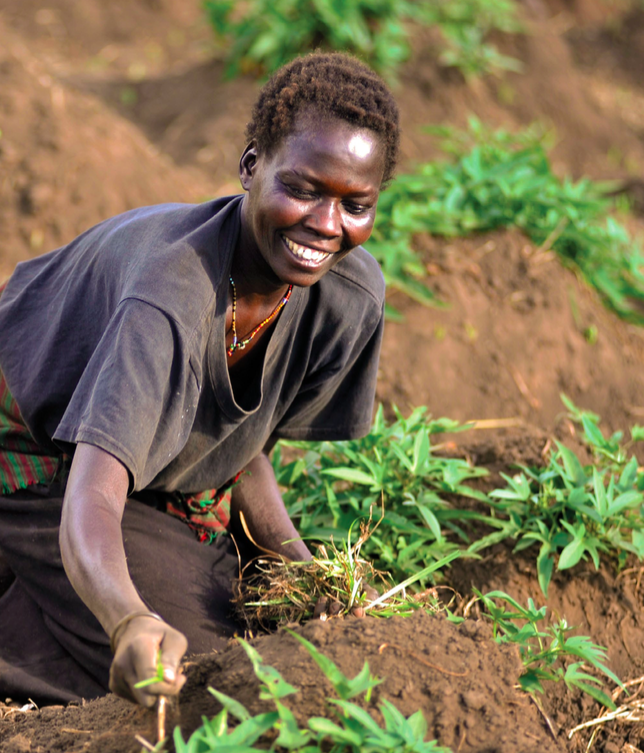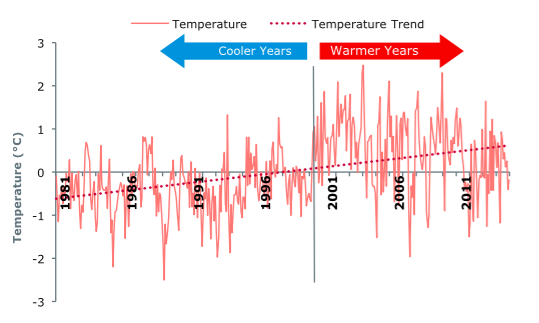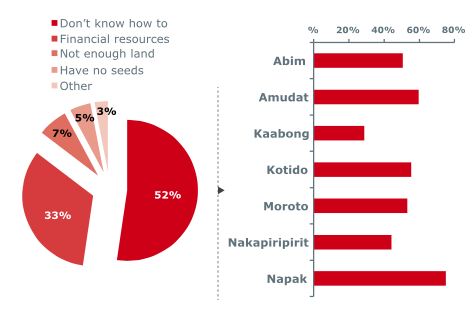Case-study /
Impacts of climate change on food security and livelihoods in Karamoja

Introduction
Karamoja’s population is highly dependent on subsistence agriculture, which is sensitive to climate conditions. The region is the most impoverished in Uganda, with the poorest development indicators, and suffers chronic food insecurity due to the combined impacts of high levels of poverty, low human development and unfavourable climatic and weather conditions. However, little is known about the specific impacts of climate change on household food security, and in particular, the ability of households to adapt to climate change over time. This has resulted in gaps in food security and resilience programming.
The objective of this study* is to facilitate efforts in mainstreaming climate change adaptation into broader resilience programming initiatives, and to identify appropriate adaptation policies and programmes that support the most vulnerable and food insecure communities in the Karamoja region. It provides information on the existing threats to food security and livelihoods among households, and how climate change will exacerbate the situation due to a combination of factors that include the increasing frequency and intensity of climate hazards, diminishing agricultural yields and reduced production in the vulnerable region of Karamoja and the neighboring areas. It includes a household analysis that explores climate shocks and coping, perceptions of climate change, access to climate information services and adaptation to climate change, including the role of local institutions.
*For further information please download the full report from the right-hand column. Key findings and recommendations from the report can be foudn below. See the full text for much more detail.
Methods and Tools – Household Analysis
Specific, objectives of this study were to:
- Develop a standard climate change questionnaire module to be incorporated into regular food security assessments;
- Assess climate change risks and adaptation approaches among households in Karamoja; and
- Identify and disseminate key programme innovations to address risks associated with climate change.
The assessment covered all 7 districts of Karamoja viz. Abim, Amudat, Kaabong, Kotido, Moroto, Nakapiripirit and Napak. It involved questionnaire sampling using a two stage cross-sectional cluster sampling methodology, with the village as the geographical unit, and focus group discussions. The bjectives of the discussions were to:
- Assess local/community perceptions, understanding and indicators of climate variability and change;
- Assess the most vulnerable livelihoods based on community’s perception;
- Identify current and potential adaptation options for local communities with investment projections.
Four focus groups were conducted in each zone; male, female, youth and forecasters. Youth and forecaster FGDs were mixed (male and female); Each focus group comprised of a minimum of 15 people and a maximum of 20 people to ensure rich discussion and participation of all.
Detailed results of the household analysis can be found in chapter 3 of the report (from page 29).
Key findings (abridged)
The report offers numerous key findings from analyses of climate change predictions, at the household scale of impact and across the gender divide. The main results are summarised below.
Climate analysis
- Average monthly rainfall and temperature in Karamoja has increased over the last 35 years.
- There is however a corresponding increase in rainfall variability over the same period.
- Increasing rainfall during the September, October, November period could potentially extend the growing season in Karamoja.

Household level analysis
- Droughts/prolonged dry spells were the most common climatic shock in the last five years.
- Nearly two-thirds of respondents have not perceived any changes in climate, and half of respondents do not think the climate will continue to change over their lifetime.
- Own knowledge and indigenous information systems are the most common sources of climate information services.
- Charcoal/firewood production is recognised by communities to degrade the environment however they have no alternatives.
- Receiving climate information services and being a member of a formal/informal group were positively associated with households’ ability to adapt to climate change.

Gender analysis
- Climate shocks and coping:There was no significant difference in the percentage of female compared to male headed households that reported being impacted by the enumerated climate shocks in the last five years. There was no significant difference in the percentage of female compared to male headed households that sold assets in order to cope with climate shocks. However, it was noted that female headed households generally owned fewer assets, particularly livestock (the most frequently sold asset).
- Perceptions of climate change:Female household heads were less likely to have noticed changes in climate/weather patterns over their lifetimes and were more likely to not know/be unsure if they had noticed changes.There was no significant difference in the percentage of female compared to male headed households and their perception of the likelihood of future climate change.
- Access to and utilization of Climate Information Services (CISs):There was no significant difference in the percentage of female compared to male headed households that had access to CISs. However it was noted that female headed households were considerably less likely to own radios, which were one of the most popular sources of information. Female headed households were less likely to have sourced CISs from indigenous information systems and NGOs. However they were more likely to have sourced CISs from government extension workers. Female headed households were less likely to have utilized seasonal climate forecasts and post harvest management information.
- Adaptation to climate change:There was no significant difference in the percentage of female compared to male headed households that have made CCA measures. Female heads of households were however less likely to be members of formal/informal groups in their village.
Recommendations
Based on the key findings, this report goes on to suggest various recommendations to be put in place. These would serve to bolster existing adaptation initiatives as well as instigate new strategies and ideas in Karamoja. They are summarised below.
- Encourage Water Harvesting and Conservation Schemes: Erratic rainfall has historically been a major factor inhibiting agricultural production in Karamoja and the trend of increasing rainfall variance and temperatures further threatens water security in the region. Therefore, there is a need for multi-stakeholder investment in water harvesting and conservation solutions if food availability is to be stabilised in the region in the medium to long- term.
- Sensitize Households to the Threat Posed by Climate Change:Across Karamoja there is a lack of awareness and knowledge about climate change and its impacts. The inability to recognise climate change will reduce the likelihood of adaptive measures being made. Efforts are therefore required to sensitize households in order to strengthen awareness and spur adaptation. Furthermore, it is necessary to educate households on the most appropriate changes they can make to adapt to the impacts of climate change to increase their resilience.
- Improve Access to Climate Information Services (CISs):Low access to CISs detrimentally affects the ability of households to make informed decisions on how to capitalise upon or prepare for future conditions, increasing their vulnerability to climate shocks and food insecurity. Should access to CISs be improved, findings suggest great potential given the high rates of information utilisation and sharing.
- Synergise Dissemination of Climate Information Services with Existing Information Systems: The heavy reliance upon own knowledge and indigenous information systems (elders/traditional forecasters and community meetings) for climate and agriculture related information represents an opportunity to integrate information dissemination efforts with these existing local sources, e.g. encouraging the use of the emerging late rainfall phase for crop production. Additionally, any incorrect or inaccurate information being perpetuated through these sources can be dispelled.
- Mainstream Gender in Climate Change Related Interventions: There is a need to focus climate change sensitisation efforts on female headed households as they were less likely to have noticed changes in climate/weather patterns. Additionally, female household access to CISs through indigenous information systems and NGOs must be improved as they were considerably less likely to receive information from these popular information sources. Finally, there must be a focus upon improving membership of women in formal/ informal groups in their villages.
- Implement and/or upscale initiatives to promote drought resistant varieties:Prolonged dry spells were noted as the most common climate shock in the last five years, profoundly affecting agriculture in the region. The promotion of drought resistant varieties that are palatable with the local population is highly recommended.
- Encourage Agro-forestry Schemes: Appropriate agro-forestry schemes have the potential to reduce food insecurity in the region. Such schemes will diversify livelihoods, providing an alternative source of income and reducing the pressure on natural stands for charcoal/firewood. Additionally, this will reduce environmental degradation in the region, thereby buffering the impact of climate shocks and strengthening food insecurity.
- Increase Membership to Formal and Informal Village Groups: Over half of respondents are not members of a group. The main reasons for non-membership are the inability to meet requirements and the lack of available groups. Therefore, efforts to increase membership should focus upon knowledge and skills capacity building and/or technical assistance and group creation.
Suggested citation
WFP (2017) Impacts of climate change on food security and livelihoods in Karamoja.World Food Programme: Rome, Italy.
Further reading
- Antwi, A. (2013) Climate Change and Food Security: An Overview About the Issue. Friedrich Ebert Foundation
- CDKN (2015) Economic Assessment of the Impacts of Climate Change in Uganda: Key Results. Climate and Development Knowledge Network: London, UK.
- Funk, C., Eilerts, G., Rowland, J. and White, L. (2012) A Climate Trend Analysis of Uganda. USGS Fact Sheets 2012-3062, U.S. Department of the Interior, U.S. Geological Survey, Reston, VA, USA.
- WFP (2016) July 2016 Food Security and Nutrition Assessment for Karamoja, Uganda. Analysis, Monitoring and Evaluation Unit, World Food Programme: Uganda.
- The World Food Programme's website
- The World Food Programme: Uganda website
- The World Food Programme's C-ADAPT initiative webpage
- The Research Programme on Climate Change, Agriculture and Food Security's website
- CGIAR's website
